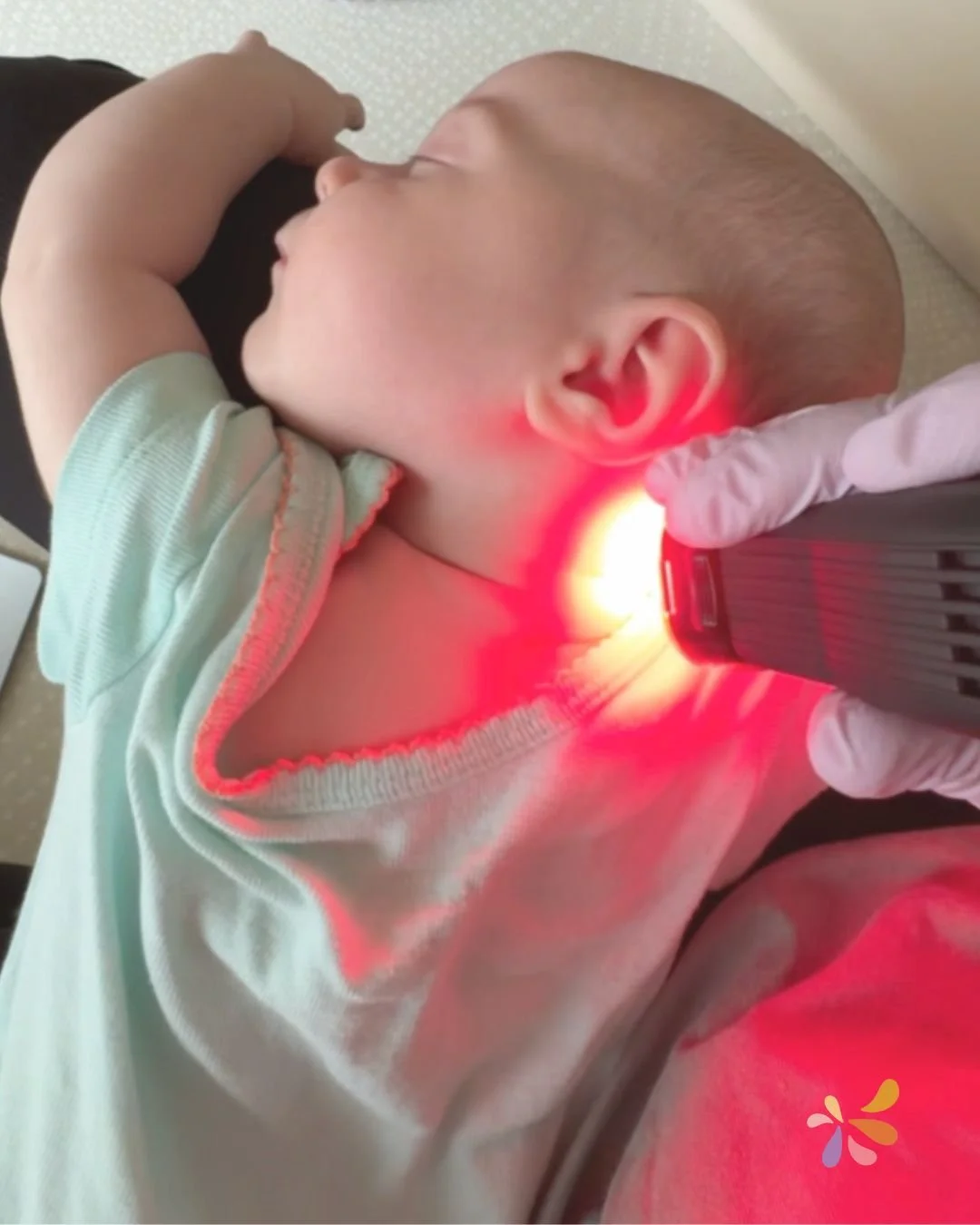Research
🍼 Infant frenectomy (tongue-tie release) – reducing pain, swelling, and improving feeding outcomes
🗣️ Speech and feeding – supporting swallowing, voice, and oral motor recovery
🧠 Neurodevelopment – enhancing emotional regulation, sleep, attention, and learning
🦵 Motor coordination and control – reducing spasticity, supporting muscle recovery, and improving motor function
😌 Pain and inflammation – aiding recovery in oral, dental, and musculoskeletal conditions
Below is a comprehensive list of studies examining LLLT across pediatric populations, along with summaries and links for deeper reading.
Infant Frenectomy (Tongue-Tie Release) Research
LLLT is increasingly applied before and after frenectomy to support comfort, healing, and oral function.
LLLT in Pediatric Oral Surgeries
Reduces postoperative pain, swelling, and speeds up oral wound healing.
👉 PubMedPhotobiomodulation for Oral Wound Healing
World Association for Photobiomodulation Therapy (WALT) guidelines support PBM for pediatric oral wound care and pain relief.
👉 WALT GuidelinesInfant Frenectomy Case Reports
Reports show improved breastfeeding outcomes (better latch, less nipple pain) and faster recovery when PBM is used post-frenectomy.
👉 PubMed Case SummaryPBM in Oral Mucositis (Children with Cancer)
Demonstrates PBM’s ability to reduce oral pain and inflammation and promote mucosal healing—mechanisms directly applicable to frenectomy.
👉 Archives of Disease in ChildhoodLLLT for Pre-Anesthetic Tissue Management
PBM reduces tissue pain/tension in children before injections, suggesting benefit for pre-frenectomy preparation.
👉 BMC Oral HealthPBM in Feeding & Speech Rehabilitation
Studies in dysphagia and speech therapy show PBM supports swallowing, oral motor recovery, and functional feeding skills.
👉 SpringerLink – Dysphagia Study
Emotional Regulation, Sleep & Neurodevelopment
Research suggests that PBM may play a role in brain function and emotional well-being in children.
Transcranial PBM in Autism (Ages 2–6)
Randomized sham-controlled trial showed improvements in emotional regulation, attention, and behavioral symptoms.
👉 FrontiersPBM in Autism Spectrum Disorder
Studies report reduced irritability, emotional dysregulation, and behavioral challenges in children with ASD.
👉 ResearchGateNeuroplasticity & Cognitive Recovery
PBM enhances neuroplasticity, supporting recovery of speech, language, and cognitive functions in neurological conditions.
👉 PubMedSleep & Regulation
LLLT was used to reduce inflammation of tonsils to increase airway capacity and allow for improved sleep quality and decreased sleep disordered breathing with good success.
Motor Coordination & Control
LLLT has been studied for its effects on spasticity, strength, and muscle recovery in children.
Impact on Spasticity in Cerebral Palsy
Systematic review shows LLLT may reduce spasticity and improve motor outcomes.
👉 MDPILLLT in Cerebral Palsy (Motor Function)
Combined with functional training, LLLT improved gross motor outcomes in children.
👉 Neuro AcupuncturePBM + Physiotherapy in Myelomeningocele
Clinical trial showed improved functional performance and motor skills.
👉 MDPIEffect on Quadriceps and Foot Muscles
LLLT reduced muscle fatigue, improved strength, and supported exercise recovery in children.
👉 PubMed Central
Additional Pediatric Research
Children with Energy-Protein Malnutrition (1–5 yrs)
LLLT improved salivary biomarkers in malnourished children.
👉 PubMedLLLT in Cancer Therapy-Induced Oral Mucositis
Systematic review/meta-analysis confirmed LLLT reduces severity and pain.
👉 PubMedLLLT for Oral Mucositis in Cancer Patients
Demonstrated significant pain relief and faster recovery.
👉 SpringerLinkEffect on Condylar Growth (Mandibular Deficiency)
Enhanced condylar growth when paired with functional appliances.
👉 SpringerLinkOrthokeratology & LLLT for Myopia
Both treatments slowed myopia progression.
👉 Wiley Online LibraryPBM in Chemotherapy-Induced Oral Mucositis (AML)
Reduced incidence/severity of mucositis in pediatric leukemia patients.
👉 PubMedPBM Retarding Axial Length Growth in Myopia
PBM slightly slowed axial length growth in myopic children.
👉 NaturePBM for Injection Pain in Children
Reduced pain perception during injections.
👉 BMCCurcumin vs PBM in Oral Mucositis
Both improved outcomes in cancer-related mucositis management.
👉 SpringerLink
Speech Therapy Applications of LLLT
LLLT is increasingly relevant to speech-language pathology (SLP).
Voice Disorders – Reduced inflammation, improved voice quality.
👉 PubMedAphasia Recovery – PBM promotes neuroplasticity and aids language recovery.
👉 PubMedTMJ Disorders – Reduced pain, inflammation, improved function.
👉 PubMedClinical Overview in SLP – Safe integration into therapy for voice, dysphagia, and aphasia.
👉 PubMedSwallowing Rehab – Reduced pain and inflammation in swallowing muscles.
👉 PubMedInflammatory Cytokines & TMJ Pain – LLLT lowered cytokines and pain.
👉 PubMedNeurological Speech Disorders – Improved motor control in dysarthria and apraxia.
👉 PMC
Key Takeaway
LLLT/Photobiomodulation is a safe, evidence-backed therapy with wide applications in pediatric care:
🍼 Frenectomy support – Faster healing, less pain, improved feeding
🗣️ Speech/feeding therapy – Supports swallowing, voice, and oral motor recovery
🧠 Neurodevelopment – Enhances regulation, attention, and sleep
🦵 Motor rehabilitation – Improves muscle performance and coordination
😌 Pain & inflammation – Gentle relief across oral, dental, and musculoskeletal needs
Have more questions? Let us know!
Low-Level Laser Therapy (LLLT) / Photobiomodulation for Infants & Children
Low-Level Laser Therapy (LLLT), also known as photobiomodulation (PBM), has been investigated in various studies for its potential therapeutic effects in children.
It is a gentle, non-invasive therapy that uses low-intensity light to stimulate healing and improve cellular function.
Research shows that LLLT may help with:

